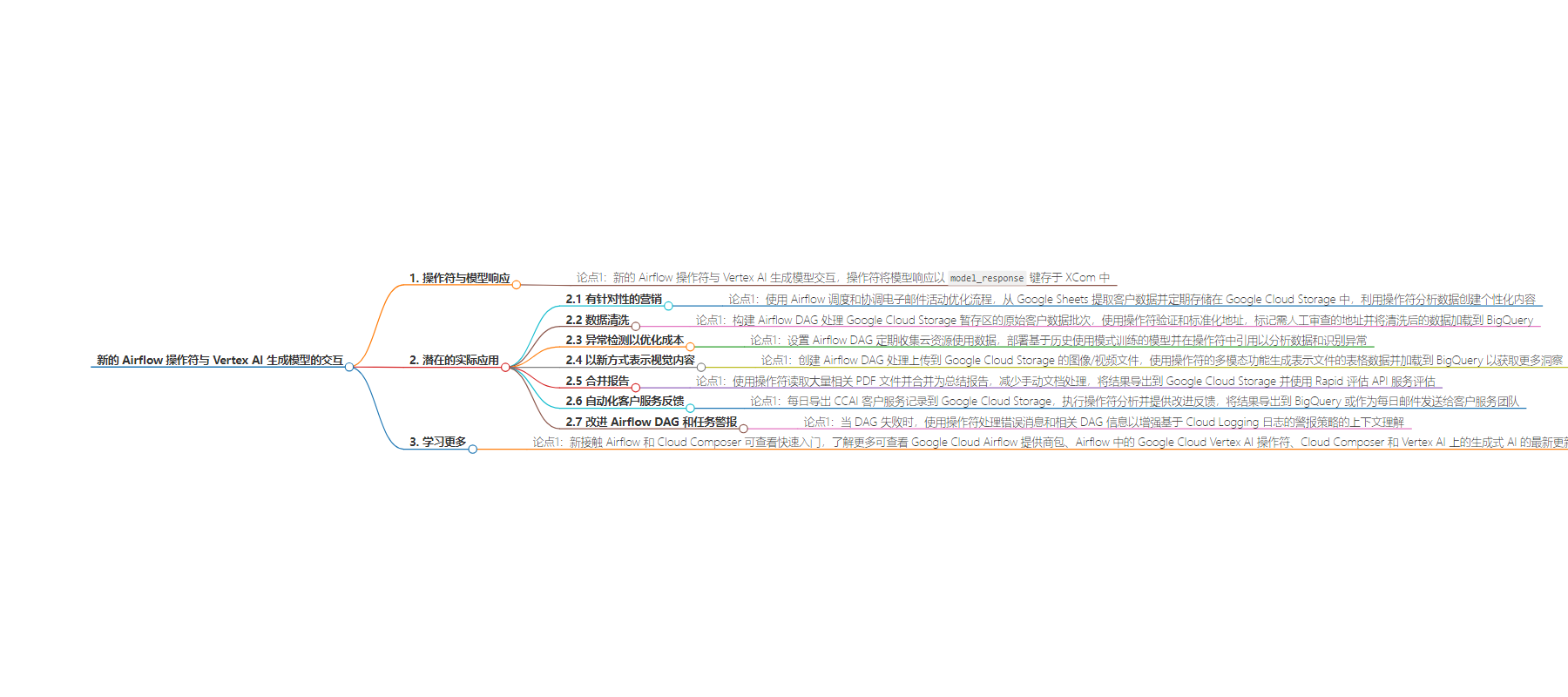包阅导读总结
1. 关键词: `Vertex AI`、`Airflow operators`、`Generative Models`、`Real-world Applications`、`Solutions`
2. 总结:
新的 Airflow 操作符与 Vertex AI 生成模型交互,每个操作符将模型响应以 `model_response` 键存于 XCom 中。文中还列举了如定向营销、数据清洗等多种潜在的现实应用场景,并指出借助相关技术,企业能开发创新解决方案。
3. 主要内容:
– Airflow 与 Vertex AI 集成:
– 新的 Airflow 操作符与 Vertex AI 生成模型交互。
– 操作符返回的模型响应在 XCom 中的 `model_response` 键下。
– 潜在的现实应用:
– 定向营销:优化邮件活动,分析客户数据以创建个性化内容。
– 数据清洗:处理和验证客户数据,将清洗后的数据加载到 BigQuery。
– 成本优化的异常检测:收集云资源使用数据,识别异常并发送警报。
– 以新方式呈现视觉内容:处理图像/视频文件,生成表格数据并加载到 BigQuery。
– 合并报告:读取和合并 PDF 文件,减少手动工作。
– 自动化客户服务反馈:分析客服记录并提供改进反馈。
– 改善 Airflow DAG 和任务警报:为错误消息添加上下文理解。
– 学习更多:
– 提供了 Airflow 和 Cloud Composer 的快速入门链接。
– 介绍获取更多信息的途径。
思维导图:
文章来源:cloud.google.com
作者:Christian Yarros
发布时间:2024/8/9 0:00
语言:英文
总字数:885字
预计阅读时间:4分钟
评分:82分
标签:生成式 AI,Apache Airflow,Vertex AI,数据分析,AI 集成
以下为原文内容
本内容来源于用户推荐转载,旨在分享知识与观点,如有侵权请联系删除 联系邮箱 media@ilingban.com
Each operator returns the model’s response in XCom under the `model_response` key.
Potential real-world applications
Expanding upon the use cases mentioned above, you can bring Vertex AI Generative Models, Apache Airflow, and Google Cloud together for potential solutions such as:
Targeted marketing: Use Airflow to schedule and orchestrate an email campaign optimization process. Extract customer data from Google Sheets and store in Google Cloud Storage on a weekly or monthly basis. Use a Google Generative Model Airflow Operator to analyze the customer data to create multiple personalized subject lines and content options for each customer segment.
Data cleansing: Build an Airflow DAG to process batches of raw customer data from a staging area in Google Cloud Storage. Leverage Google Generative Model Airflow Operators to validate and standardize addresses, correcting errors and filling in missing information when possible. Flag any addresses that require manual review and load the cleansed data into BigQuery.
Anomaly detection for cost optimization: Set up an Airflow DAG to collect cloud resource usage data from monitoring APIs on a daily or hourly basis. Deploy a Google Generative Model trained on historical usage patterns and reference the model in your Google Generative Model Airflow Operators to analyze the data and identify unusual spikes in CPU usage, network traffic, or storage consumption. If significant anomalies are detected, send alerts to the infrastructure team for investigation and corrective action.
Representing visual content in new ways: Create an Airflow DAG that triggers when image/video files are uploaded to Google Cloud Storage. Use the multimodal capabilities of Google Generative Model Airflow Operators to generate tabular data that represents these files (for example, file metadata, time-series object detection, audio transcript data, frame analysis), Load the new tabular data into BigQuery and gain further insights.
Coalescing reports: Use Google Generative Model Airflow Operators to read hundreds or thousands of related PDF files and coalesce them summarized reports. Reduce the need for manual document write-up, reviews, and internal approvals. Export results to Google Cloud Storage. Evaluate results using the Rapid evaluation API service.
Automating feedback for customer service: On a daily basis, export CCAI customer service transcripts to Google Cloud Storage. Execute Google Generative Model Airflow Operators to analyze these transcripts and provide feedback on where the customer service can be improved. Export results to BigQuery or as a daily email to the customer service team.
Improving Airflow DAG and task alerts: When a DAG fails, prompt Google Generative Model Airflow Operators with the error messages and related DAG information and use the response to add contextual understanding to a Cloud Logging log-based alerting strategy.
By leveraging this powerful trio of technologies, businesses can develop innovative solutions across various domains and use-cases.
Learn more
If you’re new to Airflow and Cloud Composer, check out our Quickstart: Run an Apache Airflow DAG in Cloud Composer 2. For even more information, check out the latest updates on the Google Cloud Airflow provider package, Google Cloud Vertex AI operators in Airflow, Cloud Composer, and generative AI on Vertex AI.
We look forward to seeing how you integrate generative AI into your Airflow DAGs!
